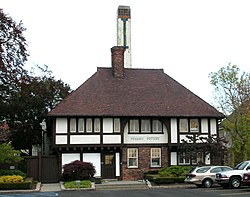Pewabic Pottery
|
Pewabic Pottery
|
|
 |
|
| Location | 10125 East Jefferson Avenue Detroit, Michigan |
|---|---|
| Coordinates | 42°21′40.92″N 82°58′54.02″W / 42.3613667°N 82.9816722°WCoordinates: 42°21′40.92″N 82°58′54.02″W / 42.3613667°N 82.9816722°W |
| Area | less than one acre |
| Built | 1908 |
| Architect | William B. Stratton; Baldwin, Frank D. |
| Architectural style | Tudor Revival, Kentish Inn |
| NRHP Reference # | 71000430 |
| Significant dates | |
| Added to NRHP | September 3, 1971 |
| Designated NHL | December 4, 1991 |
| Designated MSHS | December 11, 1970 |
Pewabic Pottery is a ceramic studio and school at 10125 East Jefferson Avenue, Detroit, Michigan. Founded in 1903, the studio is known for its iridescent glazes, some of which grace notable buildings such as the Shedd Aquarium and Basilica of the National Shrine of the Immaculate Conception. The pottery continues in operation today, and was designated a National Historic Landmark in 1991.
The pottery was founded in 1903 by the artist and teacher Mary Chase Perry Stratton and Horace James Caulkins, her business partner. Caulkins was considered a high-heat and kiln specialist, and developed the "Revelation kiln". Mary Perry Stratton was "the artistic and marketing force." The collaboration of two and their blend of art and technology gave the pottery its distinctive qualities as Detroit's contribution to the International Arts and Crafts movement and exemplified the American Craftsman Style.
The word Pewabic is derived from the Ojibwa (or Chippewa) word "wabic", which means metal, or "bewabic", which means iron or steel, and specifically referring to the "Pewabic" Upper Peninsula copper mine where Ms. Stratton walked with her father. The company is well known for the unusual iridescent glaze covering the pottery and tiles created in a manner outlined by the International Arts and Crafts movement.
In 1991, Pewabic Pottery was designated as a National Historic Landmark. See also, List of National Historic Landmarks in Michigan. As Michigan's only historic pottery, the center continues to operate in a 1907 Tudor Revival building as a non-profit educational institution. They offer classes in ceramics, hold exhibitions, sell pottery made in house, showcase and sell artists from across the United States, and offer design and fabrication services.
...
Wikipedia
